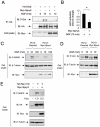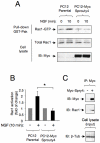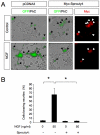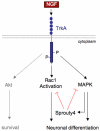Sprouty4 is an endogenous negative modulator of TrkA signaling and neuronal differentiation induced by NGF
- PMID: 22384148
- PMCID: PMC3285629
- DOI: 10.1371/journal.pone.0032087
Sprouty4 is an endogenous negative modulator of TrkA signaling and neuronal differentiation induced by NGF
Abstract
The Sprouty (Spry) family of proteins represents endogenous regulators of downstream signaling pathways induced by receptor tyrosine kinases (RTKs). Using real time PCR, we detect a significant increase in the expression of Spry4 mRNA in response to NGF, indicating that Spry4 could modulate intracellular signaling pathways and biological processes induced by NGF and its receptor TrkA. In this work, we demonstrate that overexpression of wild-type Spry4 causes a significant reduction in MAPK and Rac1 activation and neurite outgrowth induced by NGF. At molecular level, our findings indicate that ectopic expression of a mutated form of Spry4 (Y53A), in which a conserved tyrosine residue was replaced, fail to block both TrkA-mediated Erk/MAPK activation and neurite outgrowth induced by NGF, suggesting that an intact tyrosine 53 site is required for the inhibitory effect of Spry4 on NGF signaling. Downregulation of Spry4 using small interference RNA knockdown experiments potentiates PC12 cell differentiation and MAPK activation in response to NGF. Together, these findings establish a new physiological mechanism through which Spry4 regulates neurite outgrowth reducing not only the MAPK pathway but also restricting Rac1 activation in response to NGF.
Conflict of interest statement
Figures








Similar articles
-
Nerve growth factor signals through TrkA, phosphatidylinositol 3-kinase, and Rac1 to inactivate RhoA during the initiation of neuronal differentiation of PC12 cells.J Biol Chem. 2002 Sep 27;277(39):35840-6. doi: 10.1074/jbc.M203617200. Epub 2002 Jul 19. J Biol Chem. 2002. PMID: 12133829
-
Tiam1 as a signaling mediator of nerve growth factor-dependent neurite outgrowth.PLoS One. 2010 Mar 19;5(3):e9647. doi: 10.1371/journal.pone.0009647. PLoS One. 2010. PMID: 20333299 Free PMC article.
-
Nerve Growth Factor Regulates Transient Receptor Potential Vanilloid 2 via Extracellular Signal-Regulated Kinase Signaling To Enhance Neurite Outgrowth in Developing Neurons.Mol Cell Biol. 2015 Dec;35(24):4238-52. doi: 10.1128/MCB.00549-15. Epub 2015 Sep 28. Mol Cell Biol. 2015. PMID: 26416880 Free PMC article.
-
NGF and ProNGF: Regulation of neuronal and neoplastic responses through receptor signaling.Adv Biol Regul. 2015 May;58:16-27. doi: 10.1016/j.jbior.2014.11.003. Epub 2014 Nov 20. Adv Biol Regul. 2015. PMID: 25491371 Free PMC article. Review.
-
Small Endogenous Ligands Modulation of Nerve Growth Factor Bioactivity: A Structural Biology Overview.Cells. 2021 Dec 8;10(12):3462. doi: 10.3390/cells10123462. Cells. 2021. PMID: 34943971 Free PMC article. Review.
Cited by
-
Feedback regulation of RTK signaling in development.Dev Biol. 2019 Mar 1;447(1):71-89. doi: 10.1016/j.ydbio.2017.10.017. Epub 2017 Oct 26. Dev Biol. 2019. PMID: 29079424 Free PMC article. Review.
-
Sprouty2 and -4 hypomorphism promotes neuronal survival and astrocytosis in a mouse model of kainic acid induced neuronal damage.Hippocampus. 2016 May;26(5):658-67. doi: 10.1002/hipo.22549. Epub 2015 Nov 27. Hippocampus. 2016. PMID: 26540287 Free PMC article.
-
Mutations in FGF17, IL17RD, DUSP6, SPRY4, and FLRT3 are identified in individuals with congenital hypogonadotropic hypogonadism.Am J Hum Genet. 2013 May 2;92(5):725-43. doi: 10.1016/j.ajhg.2013.04.008. Am J Hum Genet. 2013. PMID: 23643382 Free PMC article.
-
The histone deacetylase complex MiDAC regulates a neurodevelopmental gene expression program to control neurite outgrowth.Elife. 2020 Apr 16;9:e57519. doi: 10.7554/eLife.57519. Elife. 2020. PMID: 32297854 Free PMC article.
-
Sprouty2-a Novel Therapeutic Target in the Nervous System?Mol Neurobiol. 2019 Jun;56(6):3897-3903. doi: 10.1007/s12035-018-1338-8. Epub 2018 Sep 17. Mol Neurobiol. 2019. PMID: 30225774 Free PMC article. Review.
References
-
- Segal RA. Selectivity in neurotrophin signaling: theme and variations. Annu Rev Neurosci. 2003;26:299–330. - PubMed
-
- Huang EJ, Reichardt LF. Trk receptors: roles in neuronal signal transduction. Annu Rev Biochem. 2003;72:609–642. - PubMed
-
- Dikic I, Giordano S. Negative receptor signalling. Curr Opin Cell Biol. 2003;15:128–135. - PubMed
-
- Mason JM, Morrison DJ, Basson MA, Licht JD. Sprouty proteins: multifaceted negative-feedback regulators of receptor tyrosine kinase signaling. Trends Cell Biol. 2006;16:45–54. - PubMed
Publication types
MeSH terms
Substances
LinkOut - more resources
Full Text Sources
Molecular Biology Databases
Research Materials
Miscellaneous

